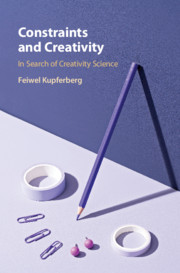Book contents
- Constraints and Creativity
- Constraints and Creativity
- Copyright page
- Contents
- Prolegomenon
- Preface
- Introduction
- Part I In Search of Creativity Science
- Part II Elaborating the Theoretical Model
- Chapter 2 Dimension I: Types of Constraints
- Chapter 3 Dimension II: Levels of Creativity
- Chapter 4 Dimension III: Getting It Right
- Chapter 5 Dimension IV: Protection of Vulnerable Versions
- Chapter 6 The Structure of Creative Processes
- Part III Conclusions: First Principles of Creativity Science
- References
- Index
Chapter 6 - The Structure of Creative Processes
from Part II - Elaborating the Theoretical Model
Published online by Cambridge University Press: 09 July 2021
- Constraints and Creativity
- Constraints and Creativity
- Copyright page
- Contents
- Prolegomenon
- Preface
- Introduction
- Part I In Search of Creativity Science
- Part II Elaborating the Theoretical Model
- Chapter 2 Dimension I: Types of Constraints
- Chapter 3 Dimension II: Levels of Creativity
- Chapter 4 Dimension III: Getting It Right
- Chapter 5 Dimension IV: Protection of Vulnerable Versions
- Chapter 6 The Structure of Creative Processes
- Part III Conclusions: First Principles of Creativity Science
- References
- Index
Summary
This chapter summarizes the four previous dimensions by combining Darwin and Aristotle. Darwin alone cannot explain Darwin mainly because his theory ultimately rested upon Aristotle’s much more fundamental theory of the structure of creative processes which is basically a theory of what makes knowledge-driven change possible. The model operates with three types of knowledge: theoretical (science), productive ( art and rhetoric) and practical (technology and moral order/ethics). These three types of knowledge constitute distinct creativity regimes, constantly confused in the literature. Technology is a practical, adaptive form of knowledge and creates new facts. Art aims at evoking emotions and transforms facts into fiction. Science aims at falsifying previous theories and separates facts from fiction. Only scientists use methodologies such as basic problem-solving strategies. Artists and orators use techniques and engineers use trial and error. Popper got the aim of science right but its core problem-solving strategy wrong.
Keywords
- Type
- Chapter
- Information
- Constraints and CreativityIn Search of Creativity Science, pp. 207 - 250Publisher: Cambridge University PressPrint publication year: 2021

